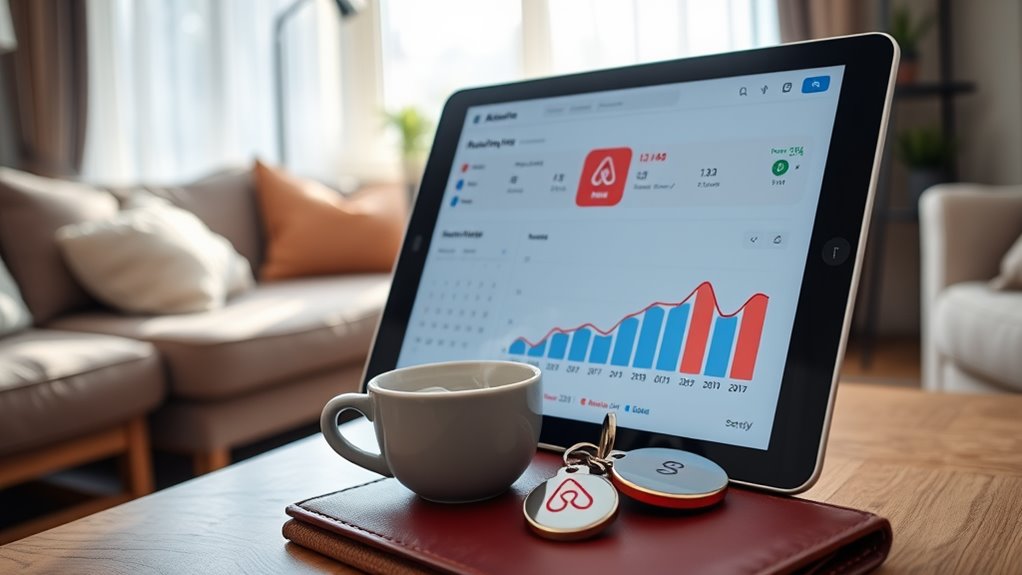You can expect to earn around $924 monthly on average, with 75% of hosts making less than $1,000. Your income depends heavily on location, occupancy rates, and pricing strategy. Urban two-bedroom units can bring in $3,200 or more, while unique properties may exceed $5,000. Earnings fluctuate with seasons, and hidden costs like maintenance and platform fees can cut into profits. Understanding these variables helps set realistic expectations and optimize your Airbnb potential. Discover more strategies to boost your revenue.
Key Takeaways
- The average Airbnb host in the U.S. earns $924 monthly, with 75% making under $1,000 and only 10% earning $2,000 or more.
- Two-bedroom urban properties can generate $3,200-$4,200 monthly, while one-bedroom units in desirable areas fetch $200-$400 nightly.
- Location is critical, with urban or tourist hotspot properties yielding the highest returns due to higher occupancy and nightly rates.
- Seasonal demand boosts earnings, with peak occupancy reaching 80-90% and nightly rates doubling during high-demand periods.
- Hidden costs include utilities, maintenance, and Airbnb’s 3% fee, but dynamic pricing and unique amenities can maximize revenue.
Average Earnings for Airbnb Hosts
Though Airbnb earnings vary widely based on location and property type, the average U.S. host earns around $924 per month, with a median of $440. Nearly three in four hosts make less than $1,000 monthly, while only 10% reach $2,000 or more. Your monthly profit largely depends on how well your Airbnb listings perform, particularly in high-demand areas where occupancy rates peak. For example, two-bedroom apartments in desirable urban locations can generate up to $3,200 monthly, considerably exceeding the national average. One-bedroom units in these areas often command nightly rates between $200 and $400, provided you maximize occupancy during peak seasons. However, even in less competitive markets, well-managed properties can still outperform traditional rentals, often by 20%-30%. To optimize your average earnings for Airbnb hosts, focus on strategic pricing, seasonal demand, and maintaining high occupancy rates. Your location and property type will ultimately shape your financial outcomes.
Factors Influencing Airbnb Income
Your Airbnb income depends on several key variables, including location, occupancy rates, and nightly pricing. High occupancy rates directly boost your profit potential, with well-managed properties in desirable areas often achieving 80-90% occupancy compared to the typical 60-70%. Nightly rates vary greatly, with urban listings commanding $150-$400, while rural properties may attract lower rates but higher occupancy during peak seasons. Seasonal fluctuations also play a vital role; implementing dynamic pricing strategies allows you to adjust rates based on demand, maximizing earnings during high-traffic periods. Property type, amenities, and guest reviews further influence income, as unique or highly-rated listings can command higher prices and attract more bookings. By strategically managing these factors—optimizing occupancy, adjusting nightly rates, and leveraging dynamic pricing—you can greatly enhance your Airbnb earnings while staying competitive in the market.
Location Impact on Profit Potential
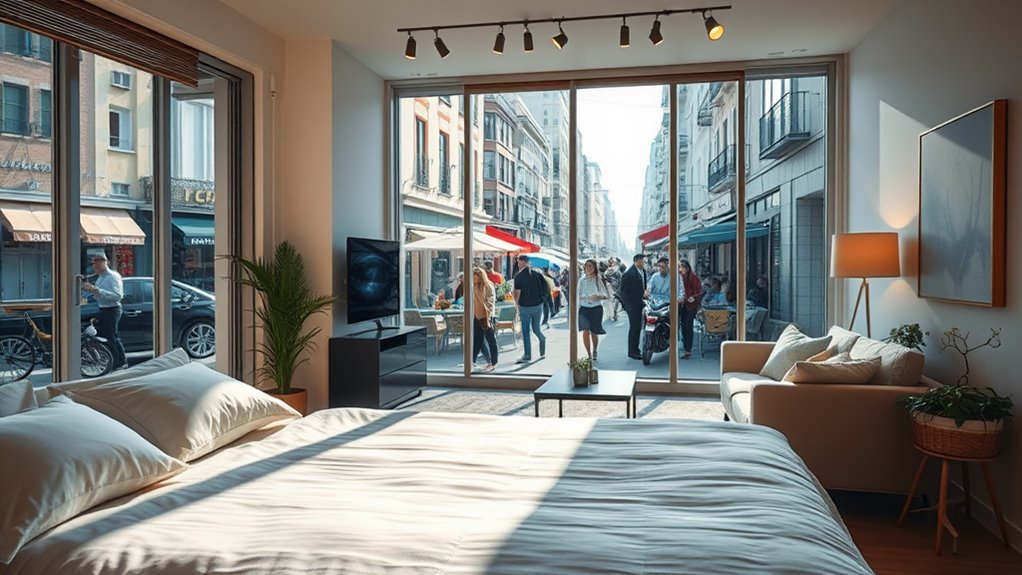
When determining how much you can earn with Airbnb, location isn’t just a factor—it’s the cornerstone of your profit potential. Your rental property’s proximity to high-demand areas directly influences both occupancy rates and nightly rates. Urban centers or tourist hotspots often generate the highest returns, with one-bedroom apartments earning AUD $200 to $400 per night. Even small geographical differences, such as being a few blocks away from key attractions, can lead to monthly income disparities of up to $1,000. Properties in densely populated areas with easy access to amenities like restaurants, transportation, and landmarks consistently outperform others. For example, a two-bedroom apartment in a highly sought-after location can average $3,200 monthly. This underscores the importance of choosing a strategic location to maximize your profit margins. Always analyze local demand patterns and competition to guarantee your property remains competitive in its market.
Seasonal Trends and Demand Fluctuations
While location plays a pivotal role in Airbnb earnings, seasonal trends and demand fluctuations can profoundly impact your income potential. Seasonal demand drives occupancy rates, which can surge to 80-90% during peak periods compared to 60-70% in off-peak months. Nightly rates also fluctuate considerably, often doubling from $100 to $200 in high-demand seasons, directly boosting your revenue. In popular tourist areas, local events or festivals can temporarily spike demand, allowing you to charge premium rates. By utilizing dynamic pricing, you can adjust your rates in real-time to align with these fluctuations, maximizing your earnings. Understanding local market trends is critical, as properties in prime locations can generate 20-30% more income during peak seasons compared to traditional rentals. Strategically aligning your pricing and availability with seasonal demand guarantees you capitalize on these lucrative opportunities.
Hidden Costs and Expenses to Consider
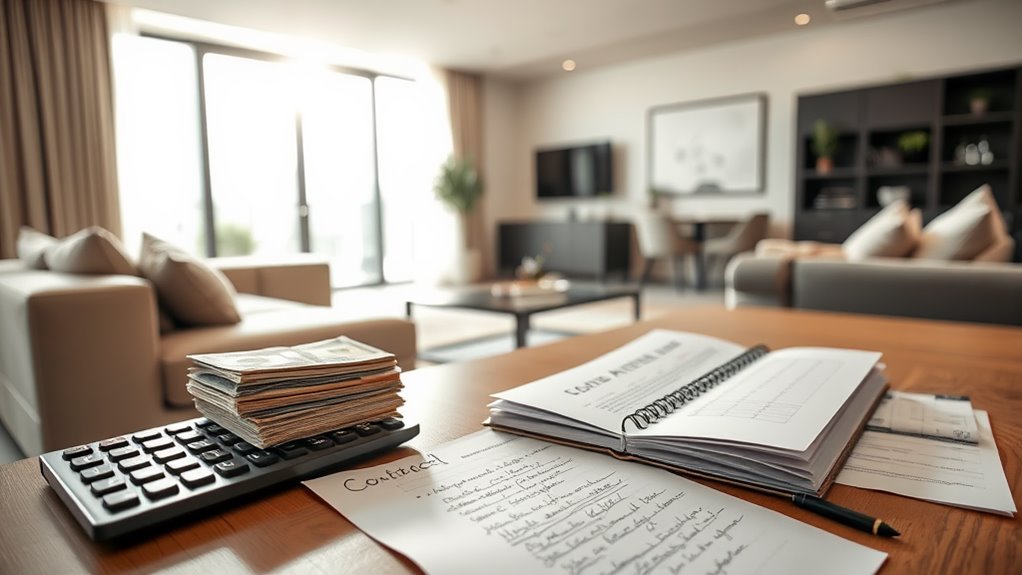
Your utility bills may rise by up to 30%, translating to an additional $50 monthly, due to increased guest usage. Routine maintenance and repairs often average around $100 per month, ensuring your property remains in top condition for visitors. You’ll need to account for these recurring costs to accurately gauge your Airbnb profitability. Additionally, understanding how seasonal fluctuations affect demand and pricing is crucial for setting competitive rates and maximizing occupancy.
Utility Bill Increases
Hosting on Airbnb can drive utility costs up by approximately 30%, as frequent guest turnover and increased usage of electricity, water, and other essentials add up quickly. On average, you can expect to pay around $50 more per month in utility bills, depending on occupancy rates and booking frequency. These expenses can greatly impact your profit margins, especially in high-demand areas where guests constantly cycle through. Additionally, amenities like Wi-Fi, heating, and air conditioning contribute to higher utility costs. While cleaning fees and other expenses may partially offset these increases, it’s vital to factor utilities into your budget to maintain a realistic expectation of passive income. Failing to account for these hidden costs can erode your earnings over time, making proactive planning essential.
Maintenance and Repairs
Maintenance and repairs for an Airbnb property often catch hosts off guard, adding hidden costs that can impact profitability. On average, you’ll spend around $100 monthly on upkeep alone, but guest turnover and wear-and-tear can drive those costs higher. Cleaning fees, ranging from $60 to $200 per booking, further reduce profit margins, while hidden costs like increased utility bills add approximately $50 extra each month. Vital maintenance tasks, such as HVAC servicing or plumbing repairs, often incur unexpected expenses that strain your budget. Additionally, Airbnb’s 3% platform fee on each booking limits your earnings, making it essential to account for all potential repair costs upfront. Failing to budget for these expenses can erode your profit margins, turning an otherwise lucrative venture into a financial burden. Plan meticulously to maintain profitability.
Strategies to Maximize Airbnb Revenue
You can adopt dynamic pricing models to adjust your rates based on demand, boosting your revenue by 20-30% during peak periods. Highlighting unique property features in your listing, such as a private pool or proximity to attractions, increases its appeal and justifies higher pricing. Leveraging targeted advertising strategies on platforms like Facebook and Instagram can further enhance your property’s visibility and attract potential guests. This combination of strategic pricing and distinctive offerings drives both occupancy and profitability.
Dynamic Pricing Models
By leveraging dynamic pricing models, hosts can strategically adjust nightly rates to align with fluctuations in demand, occupancy, and local events, potentially boosting revenue by up to 30% during peak seasons. Dynamic pricing guarantees your rates remain competitive while maximizing profitability, especially when occupancy rates are high. Tools like Airbnb’s Smart Pricing automate adjustments based on market trends, reducing manual effort while maintaining competitive pricing. Analyze local competition and occupancy trends to set rates that attract guests without sacrificing income. Seasonal adjustments, such as raising prices during holidays or local events, capitalize on increased demand. A/B testing different pricing strategies provides actionable insights into what rates drive the highest occupancy and revenue. Effective dynamic pricing not only enhances profitability but also guarantees your property stays attractive in a competitive market.
Unique Property Features
Unique properties, such as treehouses or tiny homes, often command premium nightly rates, outperforming standard listings by 20% to 50% in high-demand areas due to their distinctive appeal. Incorporating amenities like hot tubs or themed decor can boost high occupancy rates by 10% to 30%, while professional photography showcasing unique features can increase bookings by up to 40%. For real estate investing, consider adding local experiences or guided tours, which can generate an additional $150 to $300 monthly. Effective property management maximizes revenue by highlighting architectural or historical significance, which can increase bookings by 25%.
| Feature | Impact on Revenue | Occupancy Boost |
|---|---|---|
| Unique Architecture | 25% Increase | 10%-15% |
| Themed Decor | 20%-30% Higher Rates | 10%-30% |
| Local Experiences | $150-$300 Monthly Add-Ons | 5%-10% |
Real-Life Examples of Host Earnings
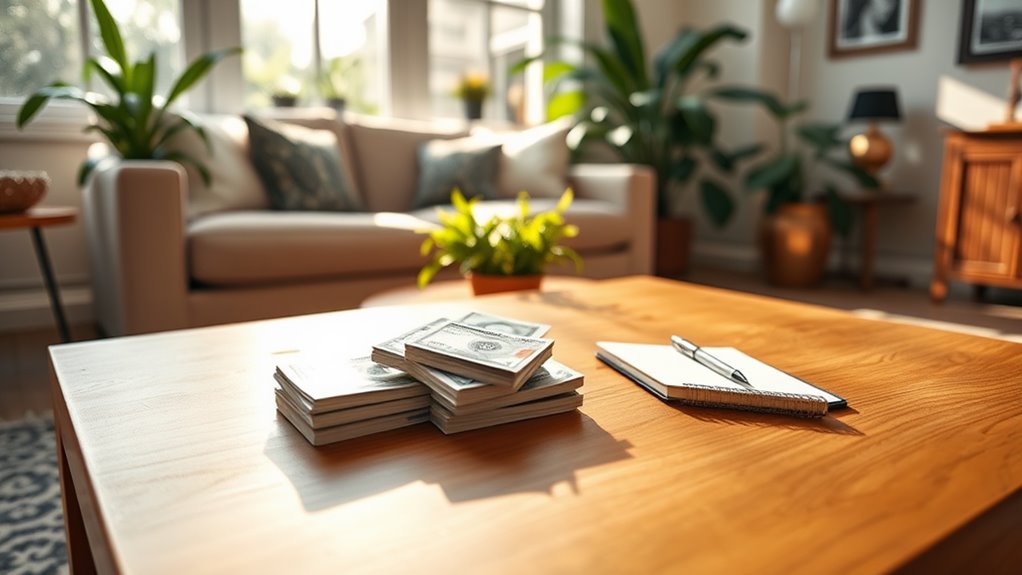
Many Airbnb hosts in major cities generate monthly earnings ranging from $3,200 to $4,200 for a two-bedroom property, driven by high occupancy rates and competitive pricing. If you’re hosting in high-demand urban areas, you can achieve nightly rates between $150 and $400, greatly boosting your short-term rental income. Case studies reveal that unique rental properties like treehouses or luxury homes often attract premium rates, sometimes exceeding $5,000 per month. In popular tourist destinations, hosts report occupancy rates of 80%-90%, especially during peak seasons, maximizing revenue potential. However, earnings vary widely; while the average host earns around $924 monthly, nearly three in four Airbnb hosts make less than $1,000. Location, property type, and market demand play critical roles in determining your success. By optimizing your pricing strategy and targeting high-demand periods, you can enhance your earnings and establish a profitable short-term rental business.
Conclusion
You can make a fortune with Airbnb—or barely break even. It all hinges on location, demand, and strategy. A prime spot in a bustling city could rake in thousands monthly, while a rural cottage might yield pennies. Seasonal spikes? Goldmines. Hidden costs? Budget killers. Crunch the numbers, optimize your listings, and price smartly. Data-driven hosts often double their earnings overnight. Dream big, but plan meticulously—your Airbnb empire’s success depends on it.
